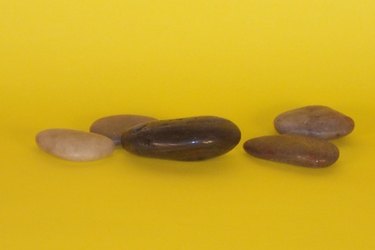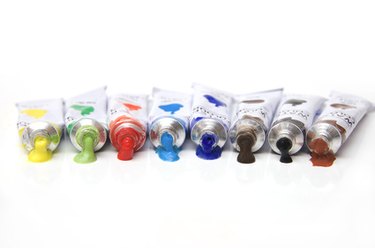
People have been painting on rock for centuries. Recently, this art activity has seen a resurgence in popularity. Rock painting is affordable when on a budget since you can pick up rocks for free in many cases.
Rocks
Video of the Day

Rocks are like fingerprints -- no two are exactly alike, which makes them a great art medium. Look for rocks on beaches, dry lake or river beds, however, always be aware of your surroundings. Taking rocks and stones from state and national parks is forbidden and be sure to get permission to hunt for rocks on private property. Rocks are everywhere, and looking for them is half the fun of this project. If the rocks are dirty, clean them with warm soapy water. Scrub them lightly with an old toothbrush, rinse them in cool water and pat them dry with an old towel.
Video of the Day
Brushes

Paint with inexpensive brushes. Depending upon the hardness or softness of the rock, the surface will wear down a brush quickly, making expensive brushes a waste. Look for brushes that are durable and have long bristles that hold a lot of paint. Consider buying a stiff brush with a wood handle. They are generally inexpensive and work well when painting on rock.
Selecting Paint

Acrylic paints have improved through the years, and finding quality paint is not as difficult as it was in years past. Use an acrylic patio paint if you plan to keep your finished piece outdoors. Patio paints are formulated specifically to weather well in the elements and are designed for porous surfaces like rock, clay pots and stepping stones. If you plan to display your art inside, any acrylic paint will work. The consistency of the paint should be neither too thick nor too thin. Add small amounts of water to thick paint until it reaches a good painting consistency. Practice painting thin lines on scrap paper or newspaper to check your paint's texture and thickness.
Sealer
There are a multitude of sealers to choose from that will ensure your art piece lasts a lifetime. Acrylic spray gloss enriches colors and provides satisfactory protection if kept indoors. Choose a spar urethane sealer if the finished rock painting will be displayed outdoors. Although spar urethane is used primarily for wood, it also works well as an outdoor paint protector for rock paintings. Spar resists cracking, peeling and yellowing and protects against water, sun damage and salt air.